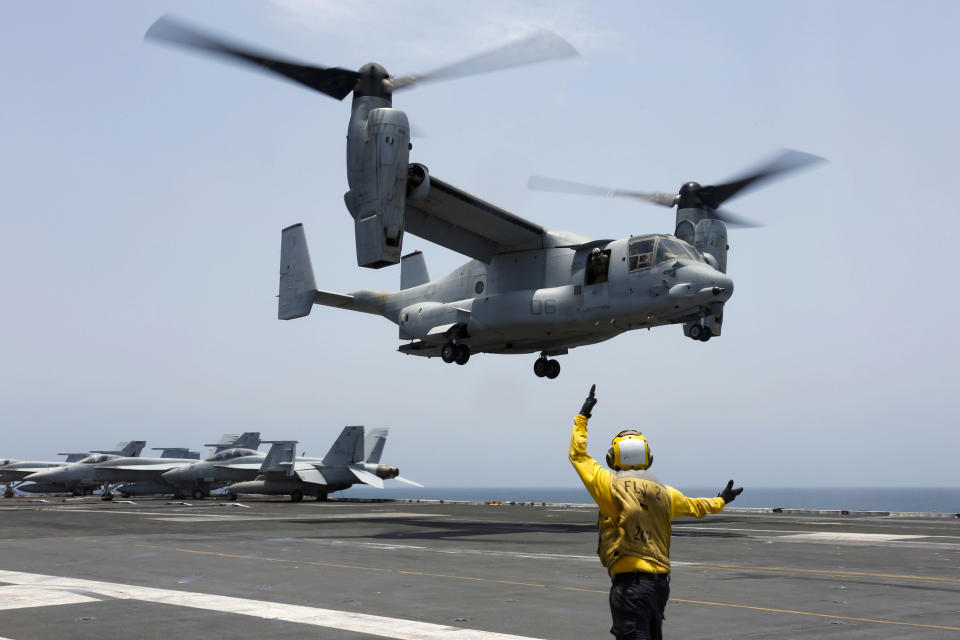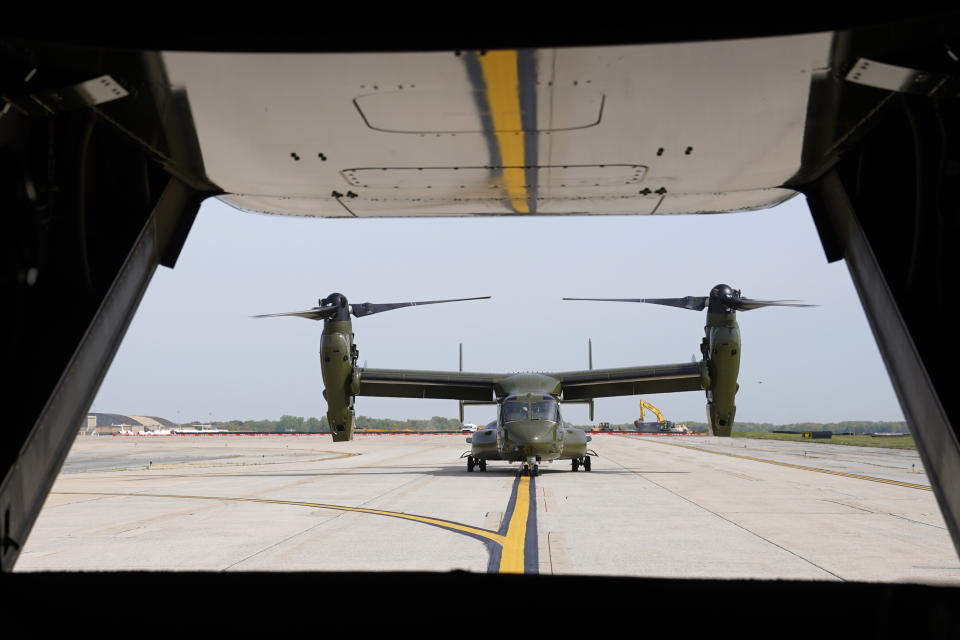Families of Marines killed in 2022 Osprey crash sue aircraft manufacturers Boeing, Bell, Rolls Royce
WASHINGTON (AP) — Families of four of the five Marines killed when their Osprey crashed in California in June of 2022 filed a federal lawsuit Thursday alleging that the aircraft's manufacturers failed to address known mechanical failures that led to the deaths.
The Marines were killed when their MV-22 Osprey experienced a catastrophic mechanical failure known as hard-clutch engagement, a known problem with the tilt-rotor aircraft that has happened more than a dozen times since 2010.
The families named Bell Textron, The Boeing Co. and Rolls Royce in their lawsuit. Bell assembles the Osprey in a partnership with Boeing in its facilities in Amarillo, Texas; Rolls Royce produces the Osprey’s engines.
The Osprey can take off or land like a helicopter but fly like an airplane. The military services have called it a game-changer in that it allows them to travel long distances quickly and land on a target, but it has not been without significant cost: More than 50 service members have been killed in accidents since 2000 in the aircraft.
The lawsuit alleges that the Osprey’s design was flawed and did not meet U.S. safety standards.
The Osprey’s two engines are linked by an interconnected drive shaft that runs inside the length of the wings. On each tip, by the engines, a component called a sprag clutch transfers torque, or power, from one proprotor to the other to make sure both rotors are spinning at the same speed. That keeps the Osprey’s flight in balance. If one of the two engines fails, the sprag clutch is also a safety feature: It will transfer power from the working side to the failing engine’s side to keep both rotors going.
When a worn clutch slips, a hard-clutch engagement can occur as the system rapidly re-engages. This creates a power spike that surges power to the other engine and can throw the Osprey into an uncontrolled roll or slide, which can cause catastrophic loss of control, leaving pilots only seconds to save their aircraft or crew.
The investigation into the 2022 crash concluded that the Marines were doing routine flight operations when they experienced a dual hard-clutch engagement, leading to a “catastrophic, unpreventable and unanticipated mechanical failure."
There were no steps the pilots could have taken to prevent it and “no means of recovery once the compound emergency commenced," the Marines' 400-page report said.
The Osprey crashed in a remote area near Glamis, about 115 miles (185 kilometers) east of San Diego.
Five Marines died in the crash: two pilots, Capt. Nicholas P. Losapio, 31, of Rockingham, New Hampshire, and Capt. John J. Sax, 33, of Placer, California; and three crew chiefs, Cpl. Nathan E. Carlson, 21, of Winnebago, Illinois, Cpl. Seth D. Rasmuson, 21, of Johnson, Wyoming, and Lance Cpl. Evan A. Strickland, 19, of Valencia, New Mexico.
As the Air Force, Navy and Marine Corps had begun looking at the problem following multiple incidents in 2022, including the fatal crash, they determined that the clutches may be wearing out faster than anticipated. The Osprey program is working on a redesign for a component that mitigates clutch slippage.
In its 2022 report, the Marine Corps warned that more accidents were possible because neither the military nor the manufacturers have been able to isolate a root cause. It said future incidents were “impossible to prevent without improvements to flight control system software, drivetrain component material strength, and robust inspection requirements.”
The lawsuit comes as families await results from investigations into two deadly Osprey crashes last year. In August of 2023, three Marines were killed in an Osprey crash off of Australia, and eight U.S. Air Force Special Operations service members were killed in November 2023 when their Osprey crashed off the coast of Japan. The Air Force took the unusual step of quickly identifying a materiel failure as a potential cause of that crash, and a week after the crash all of the services had grounded the Osprey fleet. The ban on flights was lifted three months later.
Boeing and Bell said they were unable to comment on litigation. Rolls Royce did not immediately respond to a request for comment.

 Yahoo Finance
Yahoo Finance 

